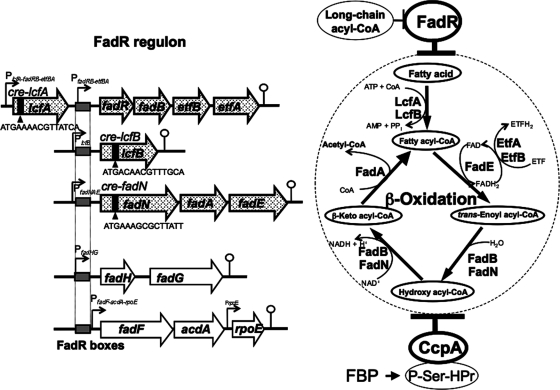Fig. 1.
The B. subtilis FadR regulon and its catabolite repression. The FadR regulon comprises the five operons (lcfA-fadRB-etfBA, lcfB, fadNAE, fadHG, and fadF-acdA-rpoE) that are involved in fatty acid β-oxidation and closely related functions (14). The lcfA-fadRB-etfBA operon possesses two promoters (PlcfA-fadRB-etfBA and PfadRB-etfBA). The FadR boxes located in the promoter regions (PfadRB-etfBA, PlcfB, PfadNAE, PfadHG, and PfadF-acdA-rpoE) are indicated by gray boxes, to which FadR binds to repress transcription from them. FadR is antagonized by long-chain acyl-CoA. Three of these five operons (lcfA-fadRB-etfBA, lcfB, and fadNAE) were found in this work to be under CcpA-dependent catabolite repression. The cre's (cre-lcfA, cre-lcfB, and cre-fadN) responsible for catabolite repression of the respective operons were located in the lcfA, lcfB, and fadN genes, to which the complex of CcpA and P-Ser-HPr binds. The formation of P-Ser-HPr is triggered by an increase in the concentration of fructose-1,6-bisphosphate (FBP). The gene products of the lcfA-fadRB-etfBA, lcfB, and fadNAE operons, which were under CcpA-dependent catabolite repression, are directly involved in fatty acid β-oxidative degradation, and their functions in β-oxidation are indicated on the right.

